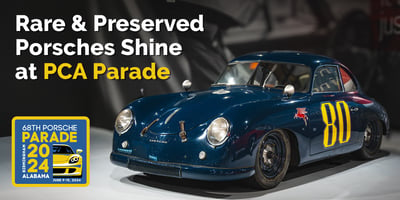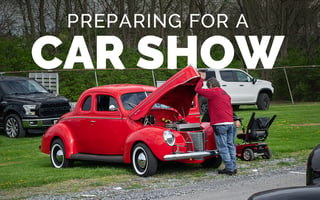The Porsche Club of America (PCA) occupies a deservedly exalted spot among the very best and most...
A Guide to the Porsche 911SC

Was the 1978-1983 Porsche 911SC the best car to ever wear the 911 badge? It’s a bold question to ask. The “Super Carrera” doesn’t have the glamour of its chrome-bumper, long-hood predecessors, nor does it have the raw power of a Turbo. It’s not nearly as quick as the 3.2 Carrera, 964, and 993 models that followed in the same bodyshell. For years, it was the most affordable way to become a 911 owner. Many were converted to SCCA and PCA racers, only to be crashed and crushed.
Yet the 911SC will live forever in history as the car that made all its descendants possible. It was impressive when it was new, and it’s still impressive today. Follow along as we talk about what made the SC great – and what you’ll want to consider as a potential owner.
Conservative Origins, Thoughtful Engineering
Porsche in the mid-seventies was a very different company from the one we know today. Fiercely independent but always short on cash, the Porsche leadership envisioned a two-model range into the eighties, with the clean-sheet, cost-no-object 928 as the flagship and the 924, developed with Volkswagen and assembled by Audi with various commodity parts, as the entry-level model. The 911SC, which debuted in 1978, was intended to be the final variant of the car, a bone thrown to the traditionalists until they saw the light and bought a 928.
For that reason, the model range was simplified to one car: the 911 Super Carrera. Why “Super”? It was an improvement on the European-market 1977 Carrera 3.0. The United States didn’t get that car, receiving only the 911S and 911 “Turbo Carrera” for 1978, so the badge didn’t make as much sense here.
Externally, the 911SC was distinguished by flared fenders, which were standard on the Euro Carrera but not seen in the USA, and by body-color headlight rings and door handles starting in the 1979 model year. Mechanically, it featured the 3.0-liter aluminum-case engine from the Carrera 3.0, tuned to make 180 horsepower (172 in California) against the 157 horses of the magnesium-case 2.7-liter 1977 911S. The 911SC was therefore both a little faster and quite a bit more durable than the previous car, ensuring that more of them survived to the present day. The sole available transmission in most years was a five-speed “915” manual box, not as pleasant as the G50 transmission that would appear years later in the Carrera 3.2 but in no way difficult to operate. Early cars could be had with the “Sportomatic” semi-auto transmission, but those are best left to enthusiasts of those particular drivetrains.
The standard equipment wheel was the 15” diameter star-spoke wheel made by ATS in Germany. These low-pressure-cast wheels were extremely strong, and many are still used on racetracks today – but the general preference, then and now, was for the optional 16” Fuchs forged wheel. It’s much easier to sell a 911SC with Fuchs, so if you’re shopping, make sure they’re the real thing and not reproductions. Original Fuchs will have a Porsche part number and a “fox head” stamping on the inside.

Available from the start in Targa, coupe, and sunroof coupe forms, the 911SC became available as a convertible for its final model year of 1983, a long-overdue option that would go on to be wildly popular with 911 buyers for the next four decades. A fair number of SCs were sold with a front spoiler and “whale tail” or “tea tray” rear spoilers, which settled the handling at extra-legal speeds. More than a few came from the factory without them but then had inferior aftermarket versions added and painted by dealers, so if you’re shopping for an SC, look for option 473 on the equipment sticker under the “frunk” hood by the latch.
For the 1981 model year, the engine was retuned for 201 horsepower. Contemporary road tests showed the 911SC easily beating the Corvette and Ferrari 308 in the quarter mile; for a few years it was the quickest new car legally sold in American showrooms.
For 1980, and to celebrate the anticipated end of the 911SC, American customers were offered 400 examples of the special “Weissach Edition”. 468 units were built, with Fuchs wheels, two color choices and the return of the original 911 Turbo Carerra’s wing on the decklid. Unlike the 911SC which dropped out of favor with Porsche owners and collectors during the nineties, the Weissachs have always been sought after.

...And The Crowd Went Wild
Not cheap by any stretch of the imagination (Car and Driver’s test 911 in 1981 cost $34,165 compared to the $19,000 Corvette, $25,600 DeLorean, and $56,850 Ferrari 308) the 911SC was nevertheless solid value in a well-built car that, by the standards of the era, was quite reliable. Customers responded, buying nearly 10,000 examples of the car every year. In 1981, Porsche hired an American CEO, Peter Schutz, who tells the following story about a visit to the office of a board member:
“I noticed a chart on the wall of Professor Bott's office. It depicted the ongoing development schedules for the three primary Porsche product lines: 944, 928 and 911. Two of them stretched far into the future, but the 911 program stopped at the end of 1981. I remember rising from my chair, walking over to the chart, taking a black marker pen, and extending the 911 program bar clean off the end of the chart. I am sure I heard a silent cheer from Professor Bott, and I knew I had done the right thing. The Porsche 911, the company icon, had been saved, and I believe the company was saved with it."
Schutz’s decision freed up funds and engineering time both for the 1983 SC convertible and a successor to the 911SC, which became the 1984 Carrera 3.2. Sales for the 911SC stayed strong until the end of the model year, and by then it was obvious that “saving” the 911 had been the correct choice.
The 911 Carrera 3.2 was wildly popular, selling about half again as well as the SC. For many years after the 3.2 went out of production, it was generally thought that there was no reason to buy an SC in the used market if you could get the faster and slightly more modern Carrera, so values of the earlier car fell dramatically, to under $10,000 in some cases.
Today, collectors are attracted to the lighter and simpler SC once again, especially as values of the 3.2 Carrera have soared to the point where it’s sometimes an option to just buy a brand-new 911 instead. Special attention is being given to SCs with “seventies”-style color palettes and chrome trim. Some owners are “backdating” their newer SCs with the chrome headlight rings from the 1978 model.
911SC, Film Star
The Super Carrera might not have appeared in Le Mans or Bad Boys, but it wasn’t exactly a stranger to the silver screen. The 1981 coupe driven by Michael Nouri in Flashdance sent all the right messages about the character, and who can forget Jennifer Beals running down the 2nd Street tunnel away from the car? On a more comedic note, a spoiler-equipped 911SC was the chosen ride of Office Space’s Bill Lumbergh, a car-casting choice made when values of the SC were at their absolute lowest.
The greatest 911SC film appearance, however, has to be Against All Odds, as one half of a Porsche-vs-Ferrari race through Bel Air. It’s a brilliantly shot and utterly realistic piece of film making, and it drove home a very factual point: in terms of raw pace, there was nothing to choose between the two cars.
Shopping for an SC
Interested in buying a 911SC? While there are very few bargains to be had in the market nowadays, there are a lot of good cars that have been brought out of collections and garages by the rising values, and that drastically increases your chance of finding the right car for you. The advice of the late Bruce Anderson, air-cooled Porsche guru and mechanic, always applies: “Buy the best condition you can afford”. This goes double for the 911SC, as many problems can be surprisingly expensive to put right. These were largely hand-built vehicles with parts made in Germany by suppliers that didn’t skimp on quality or cost. Don’t expect to pay Chevrolet prices, or even new Porsche prices, for the parts you need.
What to Look For

The engine of an air-cooled Porsche 911 can cost $20,000 or more to replace or rebuild, so it’s worth taking some time to look carefully at how the car you’re considering starts and runs. Start it from dead cold – and use your hand to check, albeit carefully – and walk away if it smokes heavily on startup or at all after five or ten minutes. Ask for maintenance records and pay special attention to head stud or valve guide replacement. By now, most 911SCs should have had both, especially if they have 50,000 miles or more.
Pretty much every properly maintained 911SC out there should now have “Carrera chain tensioners”, a part from the 3.2 that drastically increases engine longevity. Ask about, and examine, the “oil tubes” that often corrode and leak. If you can get a look at where the car has been sitting, that’s important as well. It’s rare for a vintage 911 to leak no oil, but there’s a difference between the small weep of a valve cover gasket and something more serious.
The transmission should shift freely and quietly when warm, and there should be no noise when the clutch pedal is depressed. The suspension, as well, should be quiet when driving on well-maintained roads.
Although the 911SC was fully galvanized, they can and do rust, so look under the carpets and under the car itself for corrosion and perforation. Unless the car you’re examining has unique features that you really want, it’s best to walk away from any 911SC that has holes in the body. They won’t be cheap to fix, and there are plenty of pampered examples out there for sale.
While the 911SC was not famous for the quality of its HVAC system, there’s an actual safety concern for which you need to watch even if you’ll never use it: the heat exchangers can allow dangerous exhaust gases into the cabin. They’re about $2,000 plus labor to replace. If you have any doubt regarding their condition, budget for and make the change immediately.
Targa tops on the 911 are fragile, especially if they are used a lot. A thousand dollars is usually sufficient to repair and recover one, and you can discuss that cost with the seller of a Targa.
911SC values are now high enough for race cars to lose their roll cages and come back to street service, so look for crash damage, especially in the nose.
One good thing about buying a used Porsche is that a PPI, or pre-purchase inspection, is a universally-accepted part of the Porsche culture – so find a good mechanic who specializes in air-cooled cars and pay what it costs to have them look at any potential purchase that makes it past your inspection. That’s money well spent.
The Best Ever?
The 911SC is great to drive, it’s gorgeous to look at, and it also just happened to save the 911 nameplate for decades to come. Does that make it the best 911 ever? Maybe not – but an increasing number of enthusiasts are deciding that it’s the best 911 for them, and it might be the best one for you, too.




